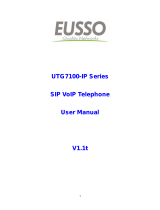
VigorIPPBX 2820 Series User’s Guide
vi
5.4 Firewall................................................................................................................................ 185
5.4.1 Basics for Firewall......................................................................................................... 185
5.4.2 General Setup............................................................................................................... 187
5.4.3 Filter Setup ................................................................................................................... 189
5.4.4 DoS Defense ................................................................................................................ 196
5.5 Objects Settings.................................................................................................................. 199
5.5.1 IP Object....................................................................................................................... 199
5.5.2 IP Group ....................................................................................................................... 201
5.5.3 Service Type Object ..................................................................................................... 202
5.5.4 Service Type Group...................................................................................................... 203
5.5.5 Keyword Object ............................................................................................................ 204
5.5.6 Keyword Group............................................................................................................. 205
5.5.7 File Extension Object.................................................................................................... 206
5.6 CSM .................................................................................................................................... 208
5.6.1 APP Enforcement Profile.............................................................................................. 209
5.6.2 URL Content Filter Profile............................................................................................. 212
5.6.3 Web Content Filter Profile............................................................................................. 216
5.7 Bandwidth Management ..................................................................................................... 220
5.7.1 Sessions Limit............................................................................................................... 220
5.7.2 Bandwidth Limit ............................................................................................................ 221
5.7.3 Quality of Service.......................................................................................................... 222
5.8 Applications......................................................................................................................... 229
5.8.1 Dynamic DNS............................................................................................................... 229
5.8.2 Schedule....................................................................................................................... 231
5.8.3 RADIUS........................................................................................................................ 233
5.8.4 UPnP............................................................................................................................. 234
5.8.5 IGMP............................................................................................................................. 236
5.8.6 Wake on LAN................................................................................................................ 237
5.9 VPN and Remote Access.................................................................................................... 238
5.9.1 Remote Access Control................................................................................................ 238
5.9.2 PPP General Setup ...................................................................................................... 239
5.9.3 IPSec General Setup.................................................................................................... 240
5.9.4 IPSec Peer Identity....................................................................................................... 241
5.9.5 Remote Dial-in User ..................................................................................................... 243
5.9.6 LAN to LAN................................................................................................................... 247
5.9.7 Connection Management.............................................................................................. 256
5.10 Certificate Management.................................................................................................... 257
5.10.1 Local Certificate.......................................................................................................... 257
5.10.2 Trusted CA Certificate ................................................................................................ 259
5.10.3 Certificate Backup....................................................................................................... 260
5.11 ISDN.................................................................................................................................. 260
5.11.1 Basic Concept............................................................................................................. 260
5.11.2 General Setup............................................................................................................. 261
5.11.3 Dial to Single ISP........................................................................................................ 264
5.11.4 Dial to Dual ISPs......................................................................................................... 265
5.11.5 Call Control................................................................................................................. 267
5.12 IP PBX............................................................................................................................... 268
5.12.1 Extension.................................................................................................................... 269
5.12.2 Line Setting................................................................................................................. 274
5.12.3 Dial Plan ..................................................................................................................... 281
5.12.4 PBX System................................................................................................................ 286




















